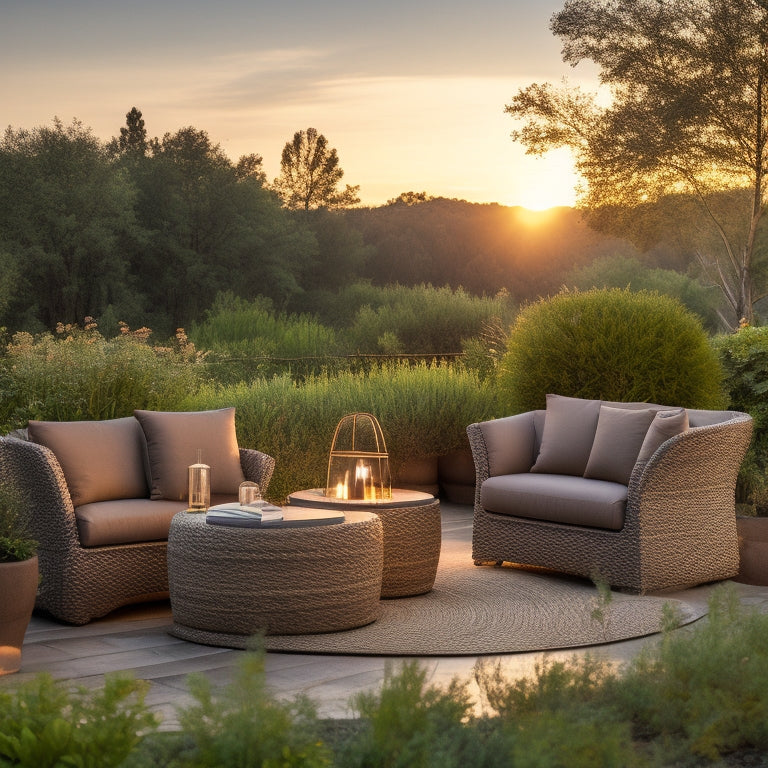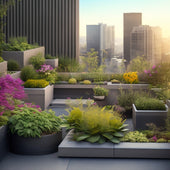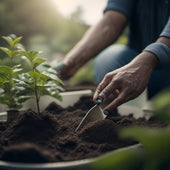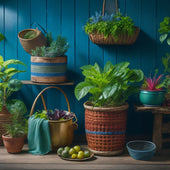
What Size Cinder Planter for Outdoor Seating
Share
When choosing a cinder planter for your outdoor seating area, consider the space's dimensions, obstacles, and intended use. For small gatherings, a planter with a diameter of 18-24 inches and height of 12-18 inches is suitable for 2-4 people. Position it 3-4 feet away from seating for comfort. For larger groups, opt for a planter with a diameter of 24-30 inches and height of 18-24 inches, accommodating 4-6 people. By balancing planter size with seating capacity and aesthetic considerations, you'll create a harmonious atmosphere. Now, refine your plan by considering the nuances of comfort, functionality, and design.
Key Takeaways
• For small gatherings, use 18-24 inches diameter, 12-18 inches height planters, suitable for 2-4 people, and position 3-4 feet away from seating.
• Allocate 20-25 square feet per person for comfortable seating capacity, considering furniture size and shape for balance.
• Choose planter size that complements seating area scale, ensuring they don't obstruct traffic flow or conversations.
• Consider color palette, texture, and shape of cinder planters to enhance visual appeal and create a cohesive look.
• For larger events, use larger planters as natural dividers or focal points, reflecting on planter size and shape for event layout coherence.
Measuring Space for Seating Areas
Measure the length, width, and any obstacles in the outdoor seating area to determine the available space for your cinder planter.
Take note of any fixed features like patio tables, fire pits, or built-in benches that will impact your seating layout. Record the outdoor dimensions, including any irregular shapes or angles, to get an accurate picture of your space.
Visualize how you want to use your outdoor seating area. Will you be hosting large gatherings or intimate dinners? Do you need to accommodate a specific number of guests?
Consider the flow of traffic and how you'll move around the space. Identify any areas where you'll need to leave clearance, such as around a grill or outdoor kitchen.
With your measurements and seating layout in mind, you can start thinking about the size and shape of your cinder planter.
You want to guarantee it fits seamlessly into your outdoor space, complementing your seating arrangement without overwhelming it.
Planter Size for Small Gatherings
For small gatherings of up to six people, consider a cinder planter with a diameter of 18-24 inches and a height of 12-18 inches, which will provide a subtle yet elegant accent to your seating arrangement without dominating the space. This size planter will allow you to create a cozy atmosphere without overwhelming the area.
Here are some general guidelines for cinder planter dimensions and planter placement tips:
| Planter Size | Seating Capacity |
|---|---|
| 18-24" diameter, 12-18" height | 2-4 people |
| 24-30" diameter, 18-24" height | 4-6 people |
| 30-36" diameter, 24-30" height | 6-8 people |
When placing your cinder planter, consider the following tips:
** Position the planter at least 3-4 feet away from the seating area to create a comfortable distance.
**Place the planter in a corner or against a wall to create a sense of enclosure.
- Balance the planter with other decorative elements, such as outdoor lighting or sculptures, to create visual harmony.
Comfortable Seating Capacity Considerations
When determining comfortable seating capacity, consider the number of people who'll be occupying the outdoor seating area, as well as the size and shape of the furniture, to guarantee a harmonious balance between seating and surrounding decor.
You'll want to create a seating arrangement that allows for easy conversation and movement. A general rule of thumb is to allocate about 20-25 square feet per person. This will give you a comfortable seating capacity that doesn't feel too cramped or too sparse.
Think about the comfort level you want to achieve. Do you want a cozy, intimate setting or a more open, airy feel? This will influence your furniture choices and the overall seating arrangement.
Consider the type of gathering you'll be hosting. Will it be a casual get-together or a more formal event? This will also impact your seating capacity needs.
Balancing Aesthetics With Functionality
As you design your outdoor seating area, you'll need to strike a delicate balance between aesthetics and functionality to create a space that's both visually appealing and functional for your guests.
To achieve this balance, consider the design elements that will enhance the visual appeal of your space. Think about the color palette, texture, and shape of your cinder planters, as well as the style and arrangement of your seating. You want to create a cohesive look that ties in with the overall aesthetic of your outdoor space.
When selecting your cinder planters, choose a size that complements the scale of your seating area. Larger planters can create a dramatic statement, while smaller ones can add a touch of whimsy.
Consider the height and width of your planters in relation to your seating, ensuring they don't obstruct the flow of traffic or block conversation.
Large Party and Event Planning
Hosting large parties and events in your outdoor seating area demands careful planning to guarantee every guest has a memorable experience.
You'll need to evaluate the number of guests, event themes, and available space to create a cohesive and functional layout. Start by allocating areas for guest accommodations, such as seating, tables, and restrooms. Ascertain these areas are easily accessible and comfortably spaced.
Next, think about the flow of your event. Designate zones for food, drinks, and entertainment to prevent congestion and promote a smooth guest experience.
Reflect on the size and shape of your cinder planters in relation to the event layout. Larger planters can serve as natural dividers or focal points, while smaller ones can add decorative touches throughout the space.
Frequently Asked Questions
Can I Use Cinder Planters as a Boundary for Outdoor Seating Areas?
You can effectively use cinder planters as a boundary for outdoor seating areas, reaping several benefits.
By doing so, you'll create a clear visual distinction between the seating area and the surrounding space, enhancing the overall aesthetic.
Plus, cinder planters are durable and low-maintenance, allowing you to focus on other aspects of your outdoor design.
They'll also add a touch of industrial chic to your boundary, creating a unique visual appeal.
Do Cinder Planters Require Special Maintenance for Outdoor Use?
You're 'testing the waters' with cinder planters for outdoor seating, and now you're wondering about maintenance.
Here's the lowdown: cinder planters are built to last, but they do require some TLC. Their durability and weather resistance depend on regular cleaning and protection from extreme temperatures.
Seal them periodically to prevent water seepage, and you'll be enjoying your outdoor oasis for years to come.
With proper care, your cinder planters will remain a sturdy boundary for your outdoor seating area.
Can I Mix and Match Different Planter Sizes and Styles?
You're considering mixing and matching different planter sizes and styles to create a unique outdoor seating area. This approach can work beautifully, as long as you're mindful of design aesthetics.
Start by selecting planters that vary in planter height to add visual interest.
Then, balance disparate styles by choosing a unifying element, such as a shared material or color palette.
How Do I Prevent Weeds From Growing in My Cinder Planters?
You're wise to think about weed prevention in your cinder planters.
To maintain a weed-free zone, you'll want to line the bottom of each planter with a weed barrier fabric. This porous material allows water to reach your plants while blocking weeds.
Next, add a layer of mulch or small rocks to further suppress weed growth.
Regularly inspect your cinder planters and remove any weeds that do manage to sprout.
With these steps, you'll be in control of your outdoor space.
Are Cinder Planters Suitable for Outdoor Seating Areas With Heavy Foot Traffic?
You're likely aware that over 70% of outdoor spaces receive heavy foot traffic, making durability a top priority.
When it comes to cinder planters in outdoor seating areas, you'll want to take into account the planter's durability in withstanding heavy foot traffic.
Look for planters with a sturdy, thick-walled construction to guarantee they can handle the constant flow of people.
Additionally, take into account the surface texture and material, as rough, porous surfaces can provide better traction and reduce slipping hazards.
Conclusion
As you finalize your outdoor seating plan, remember that a well-chosen cinder planter can elevate the entire atmosphere.
According to a study by the National Association of Landscape Professionals, 83% of homeowners believe that outdoor living spaces are essential to their overall quality of life.
By selecting the right planter size, you'll create an inviting space that encourages relaxation and socializing.
With these guidelines, you'll be well on your way to crafting an outdoor oasis that's both beautiful and functional.
Related Posts
-

Irrigation System Design Ideas for Concrete Planters
As you design an irrigation system for your concrete planters, you'll need to balance drainage, moisture retention, a...
-

Irrigation System Design Ideas for Concrete Planters
As you design an irrigation system for your concrete planters, you'll need to balance drainage, moisture retention, a...
-

Irrigation System Design Ideas for Concrete Planters
As you design an irrigation system for your concrete planters, you'll need to balance drainage, moisture retention, a...
-

Irrigation System Design Ideas for Concrete Planters
As you design an irrigation system for your concrete planters, you'll need to balance drainage, moisture retention, a...
-

Irrigation System Design Ideas for Concrete Planters
As you design an irrigation system for your concrete planters, you'll need to balance drainage, moisture retention, a...
-

Irrigation System Design Ideas for Concrete Planters
As you design an irrigation system for your concrete planters, you'll need to balance drainage, moisture retention, a...
-

Irrigation System Design Ideas for Concrete Planters
As you design an irrigation system for your concrete planters, you'll need to balance drainage, moisture retention, a...
-

Irrigation System Design Ideas for Concrete Planters
As you design an irrigation system for your concrete planters, you'll need to balance drainage, moisture retention, a...
-

Irrigation System Design Ideas for Concrete Planters
As you design an irrigation system for your concrete planters, you'll need to balance drainage, moisture retention, a...
-

Irrigation System Design Ideas for Concrete Planters
As you design an irrigation system for your concrete planters, you'll need to balance drainage, moisture retention, a...
-

Irrigation System Design Ideas for Concrete Planters
As you design an irrigation system for your concrete planters, you'll need to balance drainage, moisture retention, a...
-

Irrigation System Design Ideas for Concrete Planters
As you design an irrigation system for your concrete planters, you'll need to balance drainage, moisture retention, a...
-

Irrigation System Design Ideas for Concrete Planters
As you design an irrigation system for your concrete planters, you'll need to balance drainage, moisture retention, a...
-

Irrigation System Design Ideas for Concrete Planters
As you design an irrigation system for your concrete planters, you'll need to balance drainage, moisture retention, a...
-

Irrigation System Design Ideas for Concrete Planters
As you design an irrigation system for your concrete planters, you'll need to balance drainage, moisture retention, a...
-

Irrigation System Design Ideas for Concrete Planters
As you design an irrigation system for your concrete planters, you'll need to balance drainage, moisture retention, a...
-

Irrigation System Design Ideas for Concrete Planters
As you design an irrigation system for your concrete planters, you'll need to balance drainage, moisture retention, a...
-

Irrigation System Design Ideas for Concrete Planters
As you design an irrigation system for your concrete planters, you'll need to balance drainage, moisture retention, a...
-

Irrigation System Design Ideas for Concrete Planters
As you design an irrigation system for your concrete planters, you'll need to balance drainage, moisture retention, a...
-

Irrigation System Design Ideas for Concrete Planters
As you design an irrigation system for your concrete planters, you'll need to balance drainage, moisture retention, a...
-

Irrigation System Design Ideas for Concrete Planters
As you design an irrigation system for your concrete planters, you'll need to balance drainage, moisture retention, a...
-

Irrigation System Design Ideas for Concrete Planters
As you design an irrigation system for your concrete planters, you'll need to balance drainage, moisture retention, a...
-

Irrigation System Design Ideas for Concrete Planters
As you design an irrigation system for your concrete planters, you'll need to balance drainage, moisture retention, a...
-

Irrigation System Design Ideas for Concrete Planters
As you design an irrigation system for your concrete planters, you'll need to balance drainage, moisture retention, a...
-

Irrigation System Design Ideas for Concrete Planters
As you design an irrigation system for your concrete planters, you'll need to balance drainage, moisture retention, a...
-

Irrigation System Design Ideas for Concrete Planters
As you design an irrigation system for your concrete planters, you'll need to balance drainage, moisture retention, a...
-

Irrigation System Design Ideas for Concrete Planters
As you design an irrigation system for your concrete planters, you'll need to balance drainage, moisture retention, a...
-

Irrigation System Design Ideas for Concrete Planters
As you design an irrigation system for your concrete planters, you'll need to balance drainage, moisture retention, a...
-

Irrigation System Design Ideas for Concrete Planters
As you design an irrigation system for your concrete planters, you'll need to balance drainage, moisture retention, a...
-

Irrigation System Design Ideas for Concrete Planters
As you design an irrigation system for your concrete planters, you'll need to balance drainage, moisture retention, a...
-

Irrigation System Design Ideas for Concrete Planters
As you design an irrigation system for your concrete planters, you'll need to balance drainage, moisture retention, a...
-

5 Best Trowels for Planting in Concrete Planters
When planting in concrete planters, you need a trowel that can handle the harsh conditions and reduce fatigue on your...
-

5 Best Trowels for Planting in Concrete Planters
When planting in concrete planters, you need a trowel that can handle the harsh conditions and reduce fatigue on your...
-

5 Best Trowels for Planting in Concrete Planters
When planting in concrete planters, you need a trowel that can handle the harsh conditions and reduce fatigue on your...
-

5 Best Trowels for Planting in Concrete Planters
When planting in concrete planters, you need a trowel that can handle the harsh conditions and reduce fatigue on your...
-

5 Best Trowels for Planting in Concrete Planters
When planting in concrete planters, you need a trowel that can handle the harsh conditions and reduce fatigue on your...
-

5 Best Trowels for Planting in Concrete Planters
When planting in concrete planters, you need a trowel that can handle the harsh conditions and reduce fatigue on your...
-

5 Best Trowels for Planting in Concrete Planters
When planting in concrete planters, you need a trowel that can handle the harsh conditions and reduce fatigue on your...
-

5 Best Trowels for Planting in Concrete Planters
When planting in concrete planters, you need a trowel that can handle the harsh conditions and reduce fatigue on your...
-

5 Best Trowels for Planting in Concrete Planters
When planting in concrete planters, you need a trowel that can handle the harsh conditions and reduce fatigue on your...
-

5 Best Trowels for Planting in Concrete Planters
When planting in concrete planters, you need a trowel that can handle the harsh conditions and reduce fatigue on your...
-

5 Best Trowels for Planting in Concrete Planters
When planting in concrete planters, you need a trowel that can handle the harsh conditions and reduce fatigue on your...
-

5 Best Trowels for Planting in Concrete Planters
When planting in concrete planters, you need a trowel that can handle the harsh conditions and reduce fatigue on your...
-

5 Best Trowels for Planting in Concrete Planters
When planting in concrete planters, you need a trowel that can handle the harsh conditions and reduce fatigue on your...
-

5 Best Trowels for Planting in Concrete Planters
When planting in concrete planters, you need a trowel that can handle the harsh conditions and reduce fatigue on your...
-

5 Best Trowels for Planting in Concrete Planters
When planting in concrete planters, you need a trowel that can handle the harsh conditions and reduce fatigue on your...
-

5 Best Trowels for Planting in Concrete Planters
When planting in concrete planters, you need a trowel that can handle the harsh conditions and reduce fatigue on your...
-

5 Best Trowels for Planting in Concrete Planters
When planting in concrete planters, you need a trowel that can handle the harsh conditions and reduce fatigue on your...
-

5 Best Trowels for Planting in Concrete Planters
When planting in concrete planters, you need a trowel that can handle the harsh conditions and reduce fatigue on your...
-

7 Creative Upcycled Planter Tutorials to Try Now
Get ready to transform your outdoor space with these 7 creative upcycled planter tutorials! Start by turning cinder b...
-

7 Creative Upcycled Planter Tutorials to Try Now
Get ready to transform your outdoor space with these 7 creative upcycled planter tutorials! Start by turning cinder b...
-

7 Creative Upcycled Planter Tutorials to Try Now
Get ready to transform your outdoor space with these 7 creative upcycled planter tutorials! Start by turning cinder b...
-

7 Creative Upcycled Planter Tutorials to Try Now
Get ready to transform your outdoor space with these 7 creative upcycled planter tutorials! Start by turning cinder b...
-

7 Creative Upcycled Planter Tutorials to Try Now
Get ready to transform your outdoor space with these 7 creative upcycled planter tutorials! Start by turning cinder b...
-

7 Creative Upcycled Planter Tutorials to Try Now
Get ready to transform your outdoor space with these 7 creative upcycled planter tutorials! Start by turning cinder b...
-

7 Creative Upcycled Planter Tutorials to Try Now
Get ready to transform your outdoor space with these 7 creative upcycled planter tutorials! Start by turning cinder b...
-

7 Creative Upcycled Planter Tutorials to Try Now
Get ready to transform your outdoor space with these 7 creative upcycled planter tutorials! Start by turning cinder b...
-

7 Creative Upcycled Planter Tutorials to Try Now
Get ready to transform your outdoor space with these 7 creative upcycled planter tutorials! Start by turning cinder b...
-

7 Creative Upcycled Planter Tutorials to Try Now
Get ready to transform your outdoor space with these 7 creative upcycled planter tutorials! Start by turning cinder b...
-

7 Creative Upcycled Planter Tutorials to Try Now
Get ready to transform your outdoor space with these 7 creative upcycled planter tutorials! Start by turning cinder b...
-

7 Creative Upcycled Planter Tutorials to Try Now
Get ready to transform your outdoor space with these 7 creative upcycled planter tutorials! Start by turning cinder b...
-

7 Creative Upcycled Planter Tutorials to Try Now
Get ready to transform your outdoor space with these 7 creative upcycled planter tutorials! Start by turning cinder b...
-

7 Creative Upcycled Planter Tutorials to Try Now
Get ready to transform your outdoor space with these 7 creative upcycled planter tutorials! Start by turning cinder b...
-

7 Creative Upcycled Planter Tutorials to Try Now
Get ready to transform your outdoor space with these 7 creative upcycled planter tutorials! Start by turning cinder b...
-

7 Creative Upcycled Planter Tutorials to Try Now
Get ready to transform your outdoor space with these 7 creative upcycled planter tutorials! Start by turning cinder b...
-

7 Creative Upcycled Planter Tutorials to Try Now
Get ready to transform your outdoor space with these 7 creative upcycled planter tutorials! Start by turning cinder b...
-

7 Creative Upcycled Planter Tutorials to Try Now
Get ready to transform your outdoor space with these 7 creative upcycled planter tutorials! Start by turning cinder b...
-

7 Creative Upcycled Planter Tutorials to Try Now
Get ready to transform your outdoor space with these 7 creative upcycled planter tutorials! Start by turning cinder b...
-

7 Creative Upcycled Planter Tutorials to Try Now
Get ready to transform your outdoor space with these 7 creative upcycled planter tutorials! Start by turning cinder b...
-

7 Creative Upcycled Planter Tutorials to Try Now
Get ready to transform your outdoor space with these 7 creative upcycled planter tutorials! Start by turning cinder b...
-

7 Creative Upcycled Planter Tutorials to Try Now
Get ready to transform your outdoor space with these 7 creative upcycled planter tutorials! Start by turning cinder b...
-

7 Creative Upcycled Planter Tutorials to Try Now
Get ready to transform your outdoor space with these 7 creative upcycled planter tutorials! Start by turning cinder b...
-

7 Creative Upcycled Planter Tutorials to Try Now
Get ready to transform your outdoor space with these 7 creative upcycled planter tutorials! Start by turning cinder b...


